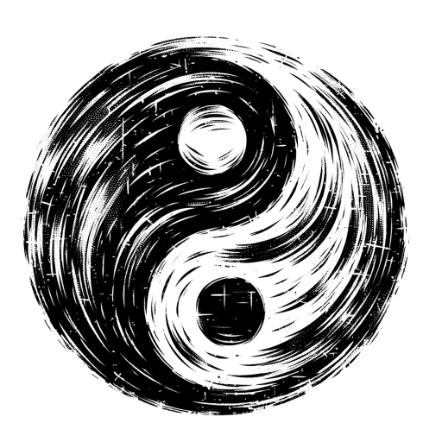
Yin-Yang Symbol
The yin-yang is an ancient Chinese symbol representing dualism. It illustrates how seemingly opposite forces are interconnected and interdependent in the natural world, contributing to the creation of a dynamic system in which the whole exceeds the sum of its parts.
Origin and Meaning
The concept of yin-yang dates back to ancient Chinese philosophy and cosmology. Yin is the symbol of earth, femaleness, darkness, passivity, and absorption. Yang, by contrast, represents heaven, maleness, light, activity, and penetration. This dualism lies at the roots of many branches of classical Chinese science and philosophy.
Symbol Design
The symbol itself is a circle divided into swirling black and white sections, each containing a dot of the opposite color. The design depicts the continuous flow of the two energies, yin and yang, which cause everything to happen. It is a visual metaphor for the dual nature of things; complementary rather than opposing forces.

Cultural Significance
In Chinese culture, the yin-yang symbol is used to describe how polar or seemingly contrary forces are interconnected. The symbol is pervasive in various forms of Chinese artChinese art encompasses a vast array of forms and influences. It has a rich history that dates back over 5,000 years and is characterized by unique regional, philosophical, and political influences that have evolved over millennia. Ancient Era The origins of Chinese art trace back to prehistoric times, highlighted by significant archaeological discoveries. These findings include pottery, jade carvings, and More, medicine, martial arts, and mythologyMythology in art taps into the rich stories and symbols from ancient cultures. These narratives shape our understanding of history, morality, and human nature, offering a profound connection between the past and the present. From the ancient Greeks to the Norse sagas, mythological themes have deeply influenced artistic expression. Greek Mythology Greek mythology is one of the most popular sources More. It embodies the belief in the balance of opposites as a fundamental aspect of the universe.
Philosophical Implications
Philosophically, the interaction of yin and yang is thought to maintain the harmony of the universe and influence everything within it. Each aspect contains the beginning point for the other, suggesting a balance where one cannot exist without the other.

Representation in Art
In art, the yin-yang symbol is used to illustrate balance and flow, emphasizing the unity and duality of life. It is a common motif in paintings, sculptures, and modern graphical design, symbolizing a deeper understanding of aesthetics and balance.
Influence on Other Cultures
The symbol has transcended its origins and is recognized globally. It has been integrated into Western culture, where it is often associated with balance and harmony in various contexts, including wellness and personal development.

Use in Modern Contexts
Today, the yin-yang symbol is used in various modern applications beyond art, such as in logos, jewelry, and tattoos. It represents personal and universal aspirations for balance and reflects a broad, universal understanding of how seemingly contradictory forces are interconnected.
Read more on yin-yang:
